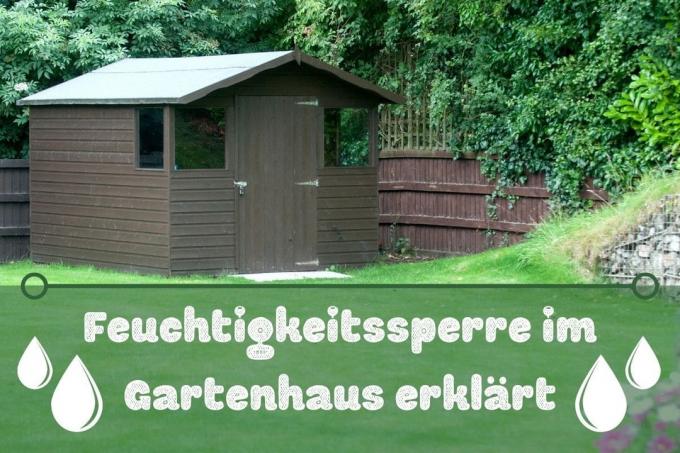
table of contents
- Moisture barrier: benefits explained
- material
- use
- frequently asked Questions
When planning a garden shed, it is necessary to incorporate a moisture barrier. It protects the substructure from rising damp from the ground.
In a nutshell
- Moisture barriers ensure that no moisture is drawn from the foundation into the wood of the substructure
- This prevents mold and rotting wood
- Modern moisture barriers are made from robust materials such as rubber granulate
- A level foundation is required for use
Moisture barrier: benefits explained
When you choose a garden shed, you have several options. There are a variety of garden houses that are designed and built in different ways. The most popular are variants that have a wooden substructure and are connected to the floor via storm brackets as required. The use of a moisture barrier, which is used between the foundation and the substructure, is necessary for such garden houses. It prevents a variety of damage that can occur due to excessive humidity:

- Rotting substructure
- Mold growth
- Risk of breakage due to material fatigue
You can prevent this problem with a moisture barrier, as the substructure is slightly elevated and no longer rests directly on the foundation. But that's not the only benefit the suspension offers. The following list gives you an overview of the properties of the lock:
- protects against rising damp
- has a sound-absorbing effect
- non-slip
- cannot slip
- not breathable (moisture is not absorbed)
- enables optimal air circulation
- dimensionally stable
Note: If you opt for a garden shed without a wooden substructure, you do not need the moisture barrier. One example are garden houses with tiles that completely dispense with a substructure.
material
Moisture barriers for garden houses are made of materials that can be used over a long period of time because they do not rot and cannot transport moisture. Rubber granulate in the form of rectangular or square pads is most often used. Rubber granulate consists of small plastic balls that are pressed into the required shape and can thus be used as pads. This gives the moisture barrier a surface that is ideal for use under the garden shed. The anti-slip properties, in particular, ensure a good stand, as the weight of the pads weighs down the pads and their surface gets caught in the foundation.

use
When using the moisture barriers, the most important thing is the correct position of the individual pads. It has a great influence on the stability of the garden house. If they are set incorrectly, the garden shed will tilt in one direction, which can cause damage. For this reason, you have to make sure that the individual pads are well positioned and, above all, in the right places when using them. The following applies:
- Distance between the pads: 10 to 20 cm
- Distances can be closer
The reason: Depending on the nature of the soil and the foundation, the slope must be compensated. This is often the case when it is not a point or cast foundation, but a variant made of concrete slabs. The inclination is compensated for by shorter gaps and multiple pads stacked on top of each other. In this way you enable a level stand for the garden shed. You should also consider the following points when using it:
- First place the substructure on the foundation
- Place a moisture barrier under the substructure
- The number of pads varies depending on the foundation
- check with spirit level and adjust
- optional: attach storm bracket
- Assemble the garden shed

Note: Another advantage of the lock is its function as a drainage. Since the substructure is elevated, excess water does not collect under your garden shed.
frequently asked Questions
If the garden shed is not too big, you can move it for a short time and equip the foundation with the lock. Make sure, however, that you have to measure the positions of the individual pads as precisely as possible, as you cannot simply remove the substructure. You would have to dismantle them for this. Then check the position of the garden shed with a spirit level.
If you opt for a garden shed that is not bolted to the foundation, you can use the moisture barriers without any problems. For this reason, foundation bolts, for example, are not suitable for the barriers, as they are firmly attached to the substructure. In the case of a point foundation, the individual foundations must have a sufficient diameter.
In most cases, moisture barriers for garden houses in finished sizes (e.g. 50 x 50 x 6 mm). Don't order too few, because depending on the size of the garden shed or the slope of the ground, not a few pads are needed. They should be made of 100 percent rubber so that they don't rot, which would also attack the wood.



